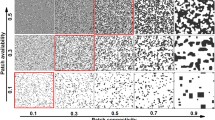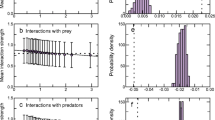Abstract
Traditionally, productivity and disturbance have been hypothesized as important determinants of food-chain length. More recently, growing empirical evidence suggests a strong role of ecosystem size. To theoretically explore the effects of basal productivity, disturbance, and ecosystem size on food-chain length, we develop and analyze a metacommunity model of intraguild predation (IGP). The model finds that, when local IGP is weak, increasing basal productivity, weakening disturbance, and increasing ecosystem size will generally increase food-chain length. When local IGP is strong, by contrast, increasing basal productivity or weakening disturbance favors intraguild predators and hinders the coexistence of intraguild predators and intraguild prey, limiting food-chain length. In contrast, increasing ecosystem size can promote coexistence even when local IGP is strong, increasing food-chain length through inserting intraguild prey and changing the degree of omnivory by intraguild predators. Intraguild prey needs to be the superior colonizer to intraguild predators for this to occur. We discuss that these theoretical predictions appear consistent with empirical patterns.







Similar content being viewed by others
References
Calcagno V, Massol F, Mouquet N, Jarne P, David P (2011) Constraints on food-chain length arising from regional metacommunity dynamics. Proc R Soc B Biol Sci 278(1721):3042–3049
Cohen JE, Newman CM (1991) Community area and food-chain length: theoretical predictions. Am Nat 138:1542–1554
DeAngelis DL, Bartell SM, Brenkert AL (1989) Effects of nutrient recycling and food-chain length on resilience. Am Nat 134:778–805
Diehl S, Feissel M (2001) Intraguild prey suffer from enrichment of their resources: a microcosm experiment with ciliates. Ecology 82:2977–2983
Elton C (1927) Animal ecology. Sidgwick and Jackson, London
Gotelli NJ (1991) Metapopulation models: the rescue effect, the propagule rain, and the core-satellite hypothesis. Am Nat 138:768–776
Harding KC, McNamara JM (2002) A unifying framework for metapopulation dynamics. Am Nat 160:173–185
Holt RD (1993) Ecology at the mesoscale: the influence of regional processes on local communities. In: Ricklefs RE, Schluter D (eds) Species diversity in ecological communities. University of Chicago Press, Chicago, pp 77–88
Holt RD (1996) Food webs in space: an island biogeographic perspective. In: Polis GA, Winemiller KO (eds) Food webs: integration of patterns and dynamics. Chapman and Hall, New York, pp 313–323
Holt RD (1997) From metapopulation dynamics to community structure: some consequences of spatial heterogeneity. In: Hanski IA, Gilpin ME (ed) Metapopulation biology: ecology, genetics, and evolution. Academic Press, Inc., San Diego
Holt RD (2002) Food webs in space: on the interplay of dynamic instability and spatial processes. Ecol Res 17:261–273
Holt RD (2010) Towards a trophic island biogeography: reflections on the interface of island biogeography and food web ecology. In: Losos JB, Ricklefs RE (eds) The theory of island biogeography revisited. Princeton University Press, Princeton, pp 143–185
Holt RD, Polis GA (1997) A theoretical framework for intraguild predation. Am Nat 149:745–764
Holt RD, Lawton JH, Polis GA, Martinez ND (1999) Trophic rank and the species–area relationship. Ecology 80:1495–1504
Hutchinson GE (1959) Homage to Santa Rosalia; or, why are there so many kinds of animals? Am Nat 93:145–159
Kidd KA, Schindler DW, Hesslein RH, Muir DCG (1998) Effects of trophic position and lipid on organochlorine concentrations in fishes from subarctic lakes in Yukon Territory. Can J Fish Aquat Sci 55:869–881
Lawton JH (1989) Food webs. In: Cherrett JM (ed) Ecological concepts. Blackwell, Oxford, pp 43–78
Leibold MA, Holyoak M, Mouquet N, Amarasekare P, Chase JM, Hoopes MF, Holt RD, Shurin JB, Law R, Tilman D, Loreau M, Gonzalez A (2004) The metacommunity concept: a framework for multi-scale community ecology. Ecol Lett 7:601–613
Levins R (1969) Some demographic and genetic consequences of environmental heterogeneity for biological control. Bull Entomol Soc Am 15:237–240
Levins R, Culver D (1971) Regional coexistence of species and competition between rare species (mathematical model/habitable patches). Proc Natl Acad Sci USA 68:1246–1248
McHugh PA, McIntosh AR, Jellyman PG (2010) Dual influences of ecosystem size and disturbance on food-chain length in streams. Ecol Lett 13:881–890
Oksanen L, Fretwell SD, Arruda J, Niemelä P (1981) Exploitation ecosystems in gradients of primary productivity. Am Nat 118:240–261
Pace ML, Cole JJ, Carpenter SR, Kitchell JF (1999) Trophic cascades revealed in diverse ecosystems. Trends Ecol Evol 14:483–488
Pauly D, Christensen V (1995) Primary production required to sustain global fisheries. Nature 374:255–257
Persson L, Bengtsson J, Menge BA, Power MA (1996) Productivity and consumer regulation—concepts, patterns, and mechanisms. In: Polis GA, Winemiller KO (eds) Food webs: integration of pattern and dynamics. Chapman and Hall, New York, pp 396–434
Pimm SL (1982) Food webs. Chapman and Hall, London
Pimm SL, Lawton JH (1977) The number of trophic levels in ecological communities. Nature 275:542–544
Polis GA, Myers CA, Holt RD (1989) The ecology and evolution of intraguild predation: potential competitors that eat each other. Annu Rev Ecol Syst 20:297–330
Post DM (2002) The long and short of food-chain length. Trends Ecol Evol 17:269–277
Post DM, Takimoto G (2007) Proximate structural mechanisms for variation in food-chain length. Oikos 116:775–782
Post DM, Pace ML, Hairston NG (2000) Ecosystem size determines food-chain length in lakes. Nature 405:1047–1049
Power ME, Parker MS, Wootton JT (1996) Disturbance and food-chain length in rivers. In: Polis GA, Winemiller KO (eds) Food webs: integration of pattern and dynamics. Chapman and Hall, New York, pp 286–297
Rosenzweig ML (1971) Paradox of enrichment—destabilization of exploitation ecosystems in ecological time. Science 171:385–387
Sabo JL, Finlay JC, Kennedy T, Post DM (2010) The role of discharge variation in scaling of drainage area and food-chain length in rivers. Science 330:965–967
Schoener TW (1989) Food webs from the small to the large. Ecology 70:1559–1589
Schoener TW, Spiller DA (1996) Devastation of prey diversity by experimentally introduced predators in the field. Nature 381:691–694
Slobodkin LB (1961) Growth and regulation of animal populations. Holt, Rinehart and Wilson, New York
Spencer M, Warren PH (1996) The effects of habitat size and productivity on food web structure in small aquatic microcosms. Oikos 75:419–430
Sterner RW, Bajpai A, Adams T (1997) The enigma of food-chain length: absence of theoretical evidence for dynamic constraints. Ecology 78:2258–2262
Takimoto G, Spiller DA, Post DM (2008) Ecosystem size, but not disturbance, determines food-chain length on islands of the Bahamas. Ecology 89:3001–3007
Wilson HB, Hassell MP, Holt RD (1998) Persistence and area effects in a stochastic tritrophic model. Am Nat 151:587–595
Yodzis P (1984) Energy flow and the vertical structure of real ecosystems. Oecologia 65:86–88
Acknowledgments
This research was supported by the Japan Society for the Promotion of Science (21770091 and 23710285 to GT), and by the National Science Foundation (DEB-0516431 to DS).
Author information
Authors and Affiliations
Corresponding author
Additional information
Gaku Takimoto is the recipient of the 15th Denzaburo Miyadi Award.
Electronic supplementary material
Below is the link to the electronic supplementary material.
About this article
Cite this article
Takimoto, G., Post, D.M., Spiller, D.A. et al. Effects of productivity, disturbance, and ecosystem size on food-chain length: insights from a metacommunity model of intraguild predation. Ecol Res 27, 481–493 (2012). https://doi.org/10.1007/s11284-012-0929-5
Received:
Accepted:
Published:
Issue Date:
DOI: https://doi.org/10.1007/s11284-012-0929-5




